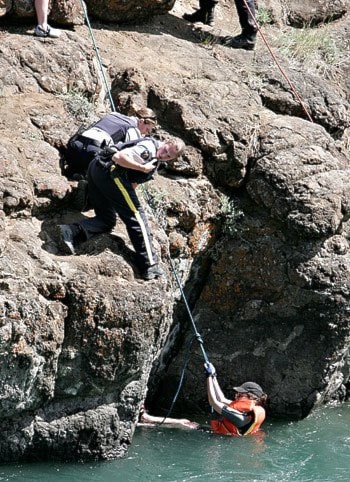If you fall into the river, don’t count on an emergency responder being there to pull you out.
Though drownings and near-drownings are pretty common here - nine people have died in Yukon waters in the last three years - emergency personnel aren’t adequately trained in river safety and rescue, says one Yukon paramedic.
“There’s ambulance workers, police and firemen who have (arrived at a scene of a drowning) and realized they didn’t have the experience or equipment to rescue somebody,” said Jason Basnett.
This month, Basnett started offering day-long river safety courses to emergency responders in the Yukon.
He’s one of only a few emergency responders fully trained in river safety and rescue. That’s thanks to previous jobs in lifeguarding, river guiding and diving.
He’s concerned first responders aren’t even given basic training in river safety. That means emergency personnel are endangering their own lives if they attempt a rescue, said Basnett.
And the temptation is always there for these people to help.
“When (emergency responders) show up, people are looking at us to do something,” he said. “It’s so easy to have someone go and help them and get pulled into the water as well.”
Last summer, two RCMP officers helped pull a kayaker out of the water near Miles Canyon.
A picture taken by the News shows two RCMP standing at the edge of a cliff assisting the woman.
“Not only are they not wearing a life jacket, but they were wearing gun and armour,” he said.
“There’s nothing worse to wear in a rescue than a fire or RCMP uniform - they’re drowning gear.
“It’s a miracle the officers didn’t drown. Had they gone down they never would have come up again.”
Officers are required to have achieved a certain level of swimming, but they don’t need to take river-rescue courses when they go through training, said RCMP Sgt. Don Rogers.
“Even so, officers still risk their lives to save people in the water with great risk to themselves,” he said.
“We’ve had members die doing that.”
Even that hasn’t convinced the police force to offer river awareness and training to its officers.
“To train every officer across Canada would be an exorbitant cost, especially for a perishable skill that needs upkeep,” said Rogers.
However, even a basic one-day course would go a long way in preventing emergency responders from putting themselves in risky situations, said Basnett.
He would like to see more tools at the disposal of paramedics and other emergency personnel to deal with river rescues.
“If there were rope bags and life jackets in every emergency vehicle we might save more lives,” he said. Currently, the vehicles lack that equipment.
A full river rescue unit in the Yukon would also be great, he added.
As a paramedic, Basnett isn’t allowed to go into the water to help save anyone. It’s against the government’s policies.
That’s a difficult thing for some paramedics to accept, he said.
“People can be right by the edge of the water and you’d have to watch them drown - it’s horrible.” That situation has happened to coworkers of his and he’s seen how destructive it has been to their psyche.
“It’s a very nasty situation. Paramedics see more deaths than anybody, but to watch someone drown or near-drown makes you feel completely powerless,” he said.
“We’re used to helping people and trying to stave off death.”
Paramedics can’t rescue people who are in the water since the government firmly keeps a “dry-boot policy,” said Whitehorse emergency services manager Terry Klassen.
It’s very similar to a house fire in that paramedics, even if they arrive first at the scene of an emergency, can’t go in to help, said Klassen.
Rescues are a collaborative effort between police, firemen and paramedics, he added, explaining the Whitehorse fire department often takes the lead on rescues.
“There have been discussions about (offering river safety courses) but our primary concern is staying safe and being able to attend to the patients once they’ve been pulled from the water,” he said.
“There’s a danger that if we enter the water we won’t be able to do the job we’re there to do, and that there’s a safety risk for our attendants.”
Basnett says he will continue to offer day-long river safety courses to emergency responders. Right now it’s voluntary, but he hopes one day workplaces will foot the bill.
Contact Vivian Belik at
vivianb@yukon-news.com
